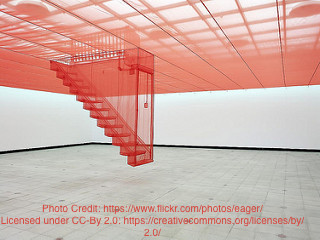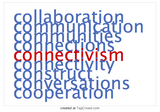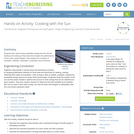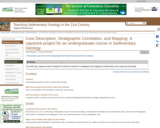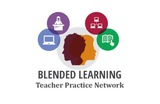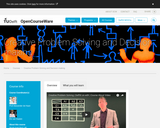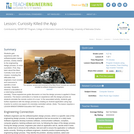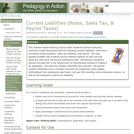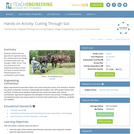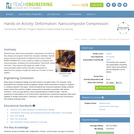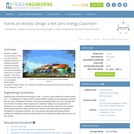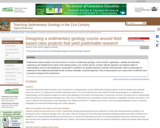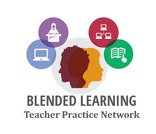This project is intended as a long-term (3 weeks -- 1 month) lab exercise near the end of a combined Stratigraphy/Sedimentology course. The project utilizes real world data provided by CONSOL Energy of Pittsburgh, PA, and the West Virginia Geological and Economic Survey. This project has been assigned once and is being revised. Instructions have been left somewhat vague in an attempt to force students into discovering some of the more mechanical details of this process themselves.
By the latter third of the course, students have described sedimentary rocks in detail and have constructed vertical sections of rock at several outcrops around campus. The course is moving from Sedimentology/Petrology into Stratigraphy. This project is designed to illustrate the basic principles of lithostratigraphy, which are covered concurrently in the lecture portion of the class.
The project 'unfurls' over several weeks. If students are provided with the entire project at one time they generally get overwhelmed, so the project is presented piecemeal, allowing the students to expand the project as they complete one section.
Step 1: Core description 40 feet of core from the Conemaugh Group of southwestern Pennsylvania is made available to the students. They must describe the core, define lithologic units, identify specific sedimentary structures, and construct a stratigraphic column. (Students struggle with detail versus efficiency of completion, given one full lab period (3 hours) and a week to complete the assignment, many students will get lost in the detail)
The goal is to build familiarity with the type of data available to geologists as they go about constructing maps for resource estimates. Additionally, the lithologies present in this core will be similar to those described in the geologist and drilling logs necessary to complete the next step.
Each step is evaluated independently in this step concern is primarily with identification of basic lithologies (coal, sandstone, shale, limestone).
Step 2: construction of strip logs for 25 core holes in northern West Virginia. Students are provided with a location map, logs for 25 holes, and elevation data. They must construct strip logs suitable for correlation, deciding upon scale and detail of presentation. Students are provided with a CD including the location map and a .pdf for each drill record.
The logs vary between the simplicity of driller data (60' of "blue" shale) and the detail of geologist descriptions, students must balance the detail and simplicity. Additionally, students were faced with "long" logs (i.e. greater than 500') and "short" logs (i.e. less than 100'). This turned out to be extremely difficult, some students got very lost, producing long detailed logs that left them without much time for the last two steps.
Students are again provided with a week to construct the strip logs, including the lab time for the week. Strip logs are evaluated for detail, accuracy, and utility (in many cases too much detail can be as confusing as too little).
Step 3: construction of stratigraphic cross sections. The first time this project was assigned, there was little guidance provided to students beyond "choosing logs that covered the largest stratigraphic interval." This exceeded the grasp of most students so additional guidance will be provided in the next iteration of this project. A generalized stratigraphic column illustrating the basic characteristics of the Monongahela and Conemaugh groups will be provided to assist students with recognition of the basic formations.
Students will be required to construct a stratigraphic cross section through selected wells on the west side of the project area. This cross section will demonstrate the use of marker beds and the lateral continuity of stratigraphic units.
The second cross section will run east-west onto the western flank of the Chestnut Ridge anticline. The datum for this cross section will be surface elevation. This cross section will illustrate the problems of stratigraphic correlation when combined with geological structures. The rock becomes consistently older as one proceeds towards the axis of the anticline. The prominent red beds and the absence of coals, in the eastern portion of the map area indicate the presence of the Chestnut Ridge Anticline.
Evaluation of the cross sections will be based upon the accuracy of the correlations. Students are allowed a week to produce cross sections (including lab). The stratigraphic cross section should accurately delineate the Redstone, Pittsburgh, and Sewickley coals. These occur in sequence and are fairly easy to identify. Successful completion of the east-west cross section will require identification of the approximate stratigraphic position of the Monongahela-Conemaugh contact.
Step 4: construction of isopach maps. Students are then required to identify specific coal and sandstone units within their cross sections, correlate those across the map region and construct isopach maps of those units.
This requires that the students now extend what they have learned from the previous three weeks, extend those correlations to the core holes not included in the basic stratigraphic analysis. The thickness of the coal and sandstone should be identified and isopach maps constructed.
The first iteration of this project produced problems similar to those encountered in step 3. Better guidance and evaluation of the cross sections and allowing students less input on the choice of stratigraphic units to isopach should reduce the confusion.
Step 5: (optional) Interpretation and report writing : the first iteration of this project was running concurrently with a term paper. Instead of two separate projects, an interpretive report will be required. This is still in the planning stage and has not been assigned to students.
(Note: this resource was added to OER Commons as part of a batch upload of over 2,200 records. If you notice an issue with the quality of the metadata, please let us know by using the 'report' button and we will flag it for consideration.)

